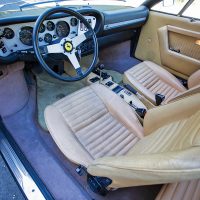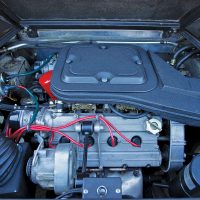SCM Analysis
Detailing
| Vehicle: | 1979 Ferrari 308 GT4 |
| Years Produced: | 1974–79 |
| Number Produced: | 2,826 |
| Original List Price: | $35,250 |
| SCM Valuation: | Median price to date, $64,900; high sale, $87,901 |
| Tune Up Cost: | $3,500 |
| Chassis Number Location: | Top frame rail, right side of engine compartment |
| Engine Number Location: | In the V of the block on the distributor side |
| Club Info: | Ferrari Club of America |
| Website: | http://www.Ferrariclubofamerica.org |
| Alternatives: | 1979 Porsche 911, 1981 Alfa Romeo GTV6, 1974 DeTomaso Pantera |
| Investment Grade: | C |
This car, Lot 236, sold for $57,750, including buyer’s premium, at Bonhams’ “Preserving the Automobile” auction at the Simeone Foundation Automotive Museum in Philadelphia, PA, on October 3, 2016.
I would have loved to have been a fly on the wall the day Enzo Ferrari was briefed on the 308 GT4.
“Il Commendatore,” — not a name used in his presence — “we want to build a mid-engine 2+2, which we haven’t done before, power it with a new V8 engine instead of your beloved V12 or your son’s V6, and have it designed and built by Bertone rather than our friends at Pininfarina.”
I suspect the response was similar to telling Donald Trump that he needs a new hairstyle — except Enzo actually signed off on the project.
Perhaps it helped that the car was to be called a Dino rather than a Ferrari, and it certainly helped that Fiat, who had become an equal partner with Enzo Ferrari in 1969, reportedly was behind the push for a Bertone design.
Following the 246 Dino would be akin to being the lead-in band to the Rolling Stones — no matter how good you are, the cards are stacked against you. If you like 246s today, imagine how revered they were in period. The 246’s performance was far from record-setting, but the light, mid-engine handling was about as good as it got in the early 1970s.
The 308 GT4 could not compete with the 246’s styling, but when it came to performance, the GT4 took the lead. The GT4 was not only faster than the 246, but the V8’s torque made the car more drivable under all conditions.
Additionally, from the steering rack to the transmission, the GT4 felt sturdier and better built.
A time-warp car worth preserving
The Simeone Foundation “Preserving the Automobile” auction featured a selection of preserved automobiles and automobiles worth preserving. The foundation seeks to educate and encourage people to preserve — rather than restore — deserving cars.
This GT4 certainly belongs in the mix. It was a time-warp example that appeared to be in very original condition, with all of its original books, tools, keys and accessories. It showed just 14,193 miles on an original-equipment, 80-mph speedometer.
This GT4 was fitted with proper Michelin XWX tires and came with receipts to back up the mileage. In 1975, Ferrari began calling the GT4s Ferraris instead of Dinos. As a 1979 model, this car was fully Ferrari badged. 1979 was the last year for U.S.-model GT4s.
This car featured all the final updates including sunroof, under-dash a/c and catalytic converters.
Delightful seat time
My wife had a similar late-series GT4, and it was an exceptional car. The GT4s have a cab-forward seating position, which gives a unique panoramic view over the steeply sloping front end. The a/c was more than adequate for a summer day in Georgia.
The mechanically operated sunroof was watertight, well positioned, and opened with the flick of the wrist. The car was not fast by today’s standards, but at the time, it would run with the big boys on track day.
An intoxicating intake and exhaust note finished the package. I often regret that we sold the car.
Unloved — until now
Despite their many virtues, GT4s have been underappreciated in the marketplace. The angular Bertone 2+2 styling was a hard sell against Pininfarina’s sexy 2-place 308 GTB and GTS.
In-period sales were sluggish, with some new GT4s going unsold for more than two years. New cars were heavily discounted and good used examples got as low as the mid-teens.
Too often, GT4 buyers could afford the car, but the upkeep of a Ferrari exceeded their budget. Deferred maintenance and decaying cosmetics were common, and many examples got an early retirement to the garage.
A couple of years ago the supply of collector-quality GT4s all but dried up. In a blink, top examples went from the mid-$20k range to $40,000, then on to $75,000 or more.
I was astonished when a sharp-but-far-from-correct 308 GT4 sold before my eyes for over $100,000 at a 2015 auction. Legend has it that a couple of meticulously restored cars have sold in the $150,000 range.
A screaming deal in Philly
If GT4s now bring big money, what happened here? High-end Ferrari buyers are quite fussy. They will pay over the top for perfection — and totally ignore anything with flaws.
Ferraris of the GT4 era were painted with lacquer paint. There was a glitch in the painting process that caused the paint to craze like an old oil painting. Crazed paint was a serious problem for 308s until Ferrari switched to enamel paint sometime after 1980.
SCM’s reporter on the scene, Adam Blumenthal, observed that under the dim auction lighting, the GT4 appeared afflicted with a few scuffs and crazing paint.
Add to that a less-than-flattering brown over matte black Boxer paint scheme, and the big money didn’t vote on this car.
I think everybody missed the boat on this car. It had everything you look for in a preservation candidate. It was a low-mileage example with a documented history. The interior appears to be original and has escaped a dye job.
The nearly unobtainable trunk carpet is intact and in good condition. The car has most — if not all — of its original jewelry, plus some complementing factory literature.
To paint or not to paint will be a dilemma, but it looks to have everything needed to be a preservation award contender.
You can’t go out and buy a car like this; you can only be there when one comes up. The model, color and condition aren’t everyone’s cup of tea, but for the right buyer, this car is a treasure.
Bonhams’ pre-sale estimate was $65,000 to $75,000. That’s an appropriate range for a nice 1979 308 GT4, but it added nothing for the extraordinary originality of this car. If the seller was a long-term owner, he went home with a smile; if the buyer understands what he bought, he went home with a steal. ♦
(Introductory description courtesy of Bonhams.)


